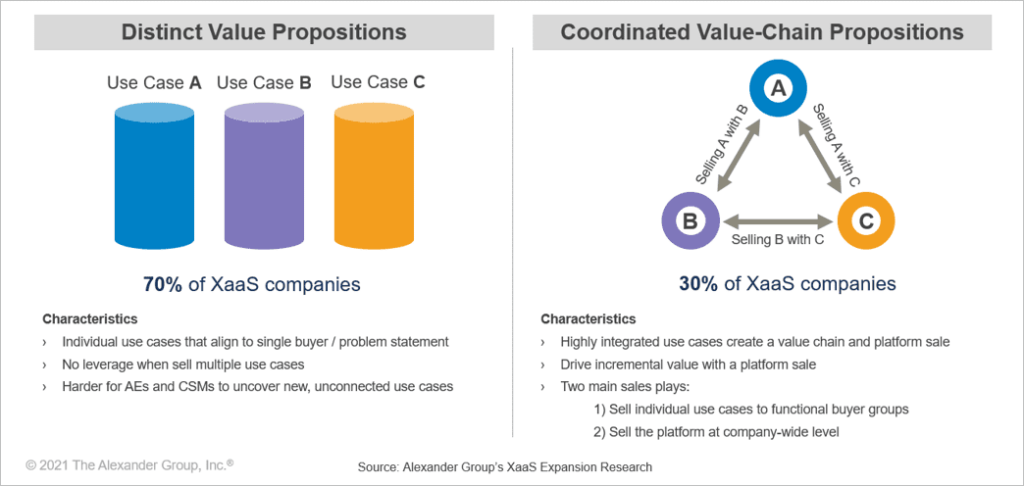Value Propositions: Emergence of Use Cases and Value Chains
Tech companies create use cases intended for a buyer and problem.
However, about a third of companies are tying these use cases together into a value-chain or ‘platform’ sale. They can now derive and sell incremental value (1+1=3) and reap success in terms of growth and profitability. The graphic below summarizes these two models.

Alexander Group’s technology practice leaders recently gathered a group of revenue growth leaders to discuss this topic. Some of them are still using distinct value propositions, while others are on their journey or already migrated to coordinated platform sales. Below are some additional findings from our discussion.
Multiple Types of Use Cases Translate to Multiple Sales Motions
One participant shared that there are different types of use cases that require different sales motions with different levels of talent.
- Existing use case for an existing market. Sellers need to be well versed at competitive positioning when selling an existing use case for an existing market.
- New use case for an existing market. Sellers need to advocate for a new value proposition that may not be expected or well-known.
- New use case for new markets (disruptors). Sellers must evangelize a new value proposition to a new market; this takes the most effort and skill to be successful.
Use Case Strategy Impacts Sales Plays
The revenue growth leaders discussed three types of sales plays that companies use.
- Use case to use case to use case. This bottom-up play is the easiest solution focused on lower-level buyers.
- Platform sale sold to C-suite. This top-down play requires selling to higher-level buyers and longer sales cycles.
- Use case to use case to platform sale. This hybrid play represents the ultimate land and expand strategy.
Developing New Use Cases Requires a Codified Process
Although some companies leverage a more rigorous process, they all acknowledged the following steps are important to codifying new use cases. Testing is the most important phase; it is critical to gather customer feedback in order to validate use cases and create well-honed value propositions.
- Identify: There are two main methods that companies use to identify new use cases:
a. Organic – track trends in data and customer requests to identify new use cases
b. Systematic – scan the market to identify new use case opportunities - Test: Test use cases with customers and partners, leveraging advisory boards when created
- Prioritize: It is important to validate internal capabilities and prioritize revenue potential of each use case
- Approve: Obtain approval from leadership
- Commercialize: Once approved, marketing must create messages and sales team must sell the use case
Questions & Next Steps
If you have any questions about these insights or other topics, please reach out and schedule a call with one of our technology practice leaders. In addition, we look forward to having you join us at our next virtual roundtable event.

